Dimitrios Loukrezis
Conformalized Polynomial Chaos Expansion for Uncertainty-aware Surrogate Modeling
Oct 25, 2025Abstract:This work introduces a method to equip data-driven polynomial chaos expansion surrogate models with intervals that quantify the predictive uncertainty of the surrogate. To that end, we integrate jackknife-based conformal prediction into regression-based polynomial chaos expansions. The jackknife algorithm uses leave-one-out residuals to generate predictive intervals around the predictions of the polynomial chaos surrogate. The jackknife+ extension additionally requires leave-one-out model predictions. The key to efficient implementation is to leverage the linearity of the polynomial chaos regression model, so that leave-one-out residuals and, if necessary, leave-one-out model predictions can be computed with analytical, closed-form expressions, thus eliminating the need for repeated model re-training. In addition to the efficient computation of the predictive intervals, a significant advantage of this approach is its data efficiency, as it requires no hold-out dataset for prediction interval calibration, thus allowing the entire dataset to be used for model training. The conformalized polynomial chaos expansion method is validated on several benchmark models, where the impact of training data volume on the predictive intervals is additionally investigated.
Polynomial Chaos Expansions on Principal Geodesic Grassmannian Submanifolds for Surrogate Modeling and Uncertainty Quantification
Jan 30, 2024



Abstract:In this work we introduce a manifold learning-based surrogate modeling framework for uncertainty quantification in high-dimensional stochastic systems. Our first goal is to perform data mining on the available simulation data to identify a set of low-dimensional (latent) descriptors that efficiently parameterize the response of the high-dimensional computational model. To this end, we employ Principal Geodesic Analysis on the Grassmann manifold of the response to identify a set of disjoint principal geodesic submanifolds, of possibly different dimension, that captures the variation in the data. Since operations on the Grassmann require the data to be concentrated, we propose an adaptive algorithm based on Riemanniann K-means and the minimization of the sample Frechet variance on the Grassmann manifold to identify "local" principal geodesic submanifolds that represent different system behavior across the parameter space. Polynomial chaos expansion is then used to construct a mapping between the random input parameters and the projection of the response on these local principal geodesic submanifolds. The method is demonstrated on four test cases, a toy-example that involves points on a hypersphere, a Lotka-Volterra dynamical system, a continuous-flow stirred-tank chemical reactor system, and a two-dimensional Rayleigh-Benard convection problem
Quadrupole Magnet Design based on Genetic Multi-Objective Optimization
Nov 17, 2022Abstract:This work suggests to optimize the geometry of a quadrupole magnet by means of a genetic algorithm adapted to solve multi-objective optimization problems. To that end, a non-domination sorting genetic algorithm known as NSGA-III is used. The optimization objectives are chosen such that a high magnetic field quality in the aperture of the magnet is guaranteed, while simultaneously the magnet design remains cost-efficient. The field quality is computed using a magnetostatic finite element model of the quadrupole, the results of which are post-processed and integrated into the optimization algorithm. An extensive analysis of the optimization results is performed, including Pareto front movements and identification of best designs.
A survey of unsupervised learning methods for high-dimensional uncertainty quantification in black-box-type problems
Feb 09, 2022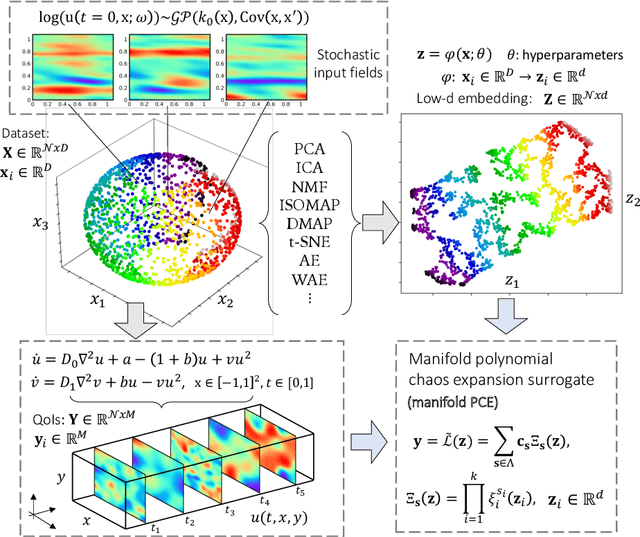
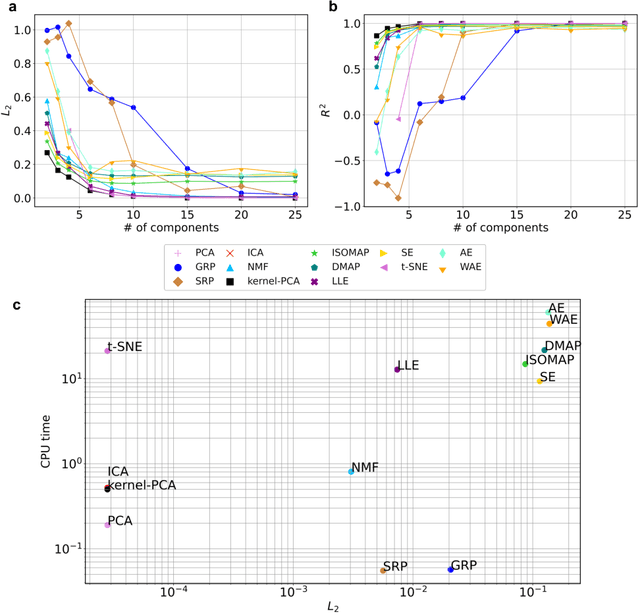
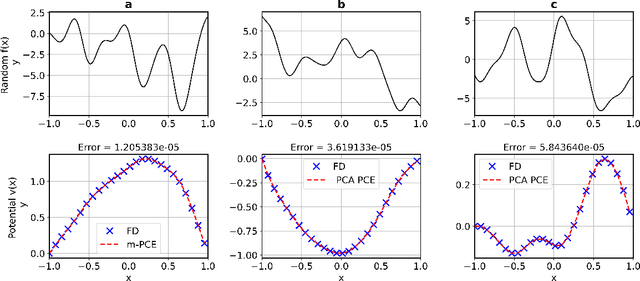
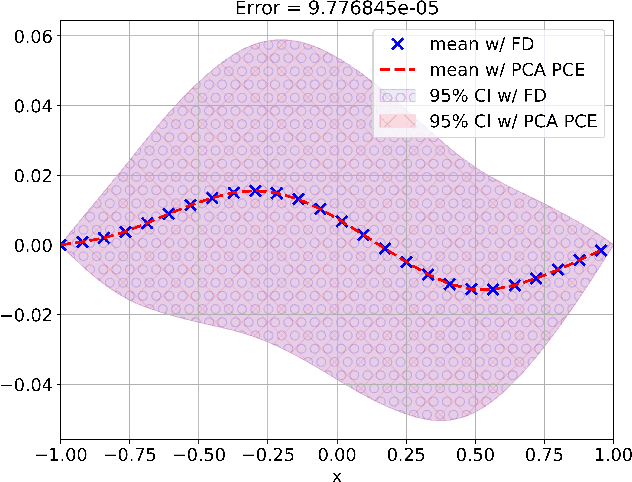
Abstract:Constructing surrogate models for uncertainty quantification (UQ) on complex partial differential equations (PDEs) having inherently high-dimensional $\mathcal{O}(10^{\ge 2})$ stochastic inputs (e.g., forcing terms, boundary conditions, initial conditions) poses tremendous challenges. The curse of dimensionality can be addressed with suitable unsupervised learning techniques used as a pre-processing tool to encode inputs onto lower-dimensional subspaces while retaining its structural information and meaningful properties. In this work, we review and investigate thirteen dimension reduction methods including linear and nonlinear, spectral, blind source separation, convex and non-convex methods and utilize the resulting embeddings to construct a mapping to quantities of interest via polynomial chaos expansions (PCE). We refer to the general proposed approach as manifold PCE (m-PCE), where manifold corresponds to the latent space resulting from any of the studied dimension reduction methods. To investigate the capabilities and limitations of these methods we conduct numerical tests for three physics-based systems (treated as black-boxes) having high-dimensional stochastic inputs of varying complexity modeled as both Gaussian and non-Gaussian random fields to investigate the effect of the intrinsic dimensionality of input data. We demonstrate both the advantages and limitations of the unsupervised learning methods and we conclude that a suitable m-PCE model provides a cost-effective approach compared to alternative algorithms proposed in the literature, including recently proposed expensive deep neural network-based surrogates and can be readily applied for high-dimensional UQ in stochastic PDEs.
Grassmannian diffusion maps based surrogate modeling via geometric harmonics
Sep 28, 2021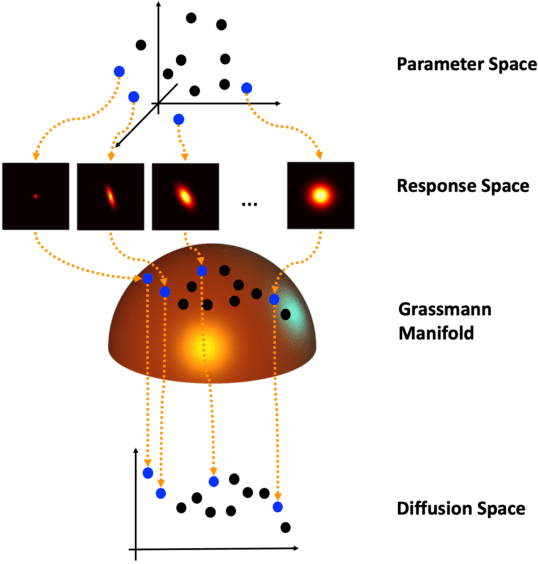

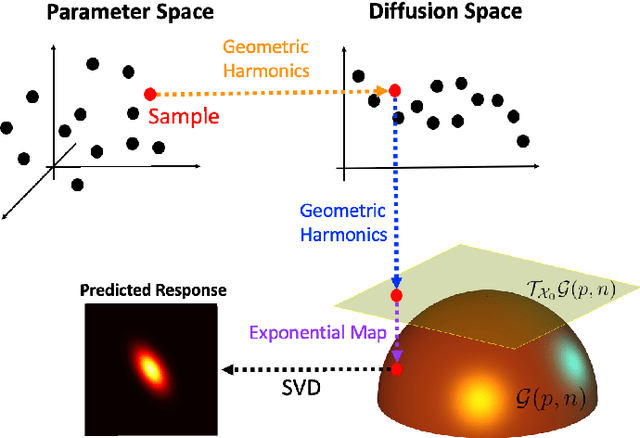
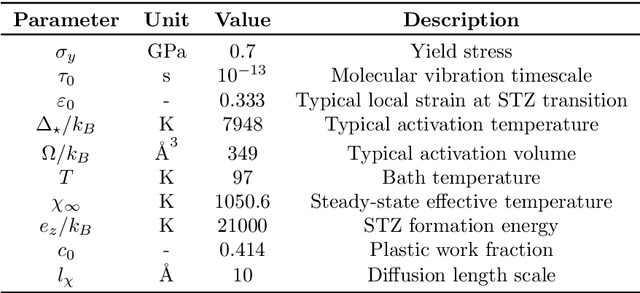
Abstract:In this paper, a novel surrogate model based on the Grassmannian diffusion maps (GDMaps) and utilizing geometric harmonics is developed for predicting the response of engineering systems and complex physical phenomena. The method utilizes the GDMaps to obtain a low-dimensional representation of the underlying behavior of physical/mathematical systems with respect to uncertainties in the input parameters. Using this representation, geometric harmonics, an out-of-sample function extension technique, is employed to create a global map from the space of input parameters to a Grassmannian diffusion manifold. Geometric harmonics is also employed to locally map points on the diffusion manifold onto the tangent space of a Grassmann manifold. The exponential map is then used to project the points in the tangent space onto the Grassmann manifold, where reconstruction of the full solution is performed. The performance of the proposed surrogate modeling is verified with three examples. The first problem is a toy example used to illustrate the development of the technique. In the second example, errors associated with the various mappings employed in the technique are assessed by studying response predictions of the electric potential of a dielectric cylinder in a homogeneous electric field. The last example applies the method for uncertainty prediction in the strain field evolution in a model amorphous material using the shear transformation zone (STZ) theory of plasticity. In all examples, accurate predictions are obtained, showing that the present technique is a strong candidate for the application of uncertainty quantification in large-scale models.
Manifold learning-based polynomial chaos expansions for high-dimensional surrogate models
Jul 21, 2021



Abstract:In this work we introduce a manifold learning-based method for uncertainty quantification (UQ) in systems describing complex spatiotemporal processes. Our first objective is to identify the embedding of a set of high-dimensional data representing quantities of interest of the computational or analytical model. For this purpose, we employ Grassmannian diffusion maps, a two-step nonlinear dimension reduction technique which allows us to reduce the dimensionality of the data and identify meaningful geometric descriptions in a parsimonious and inexpensive manner. Polynomial chaos expansion is then used to construct a mapping between the stochastic input parameters and the diffusion coordinates of the reduced space. An adaptive clustering technique is proposed to identify an optimal number of clusters of points in the latent space. The similarity of points allows us to construct a number of geometric harmonic emulators which are finally utilized as a set of inexpensive pre-trained models to perform an inverse map of realizations of latent features to the ambient space and thus perform accurate out-of-sample predictions. Thus, the proposed method acts as an encoder-decoder system which is able to automatically handle very high-dimensional data while simultaneously operating successfully in the small-data regime. The method is demonstrated on two benchmark problems and on a system of advection-diffusion-reaction equations which model a first-order chemical reaction between two species. In all test cases, the proposed method is able to achieve highly accurate approximations which ultimately lead to the significant acceleration of UQ tasks.
 Add to Chrome
Add to Chrome Add to Firefox
Add to Firefox Add to Edge
Add to Edge